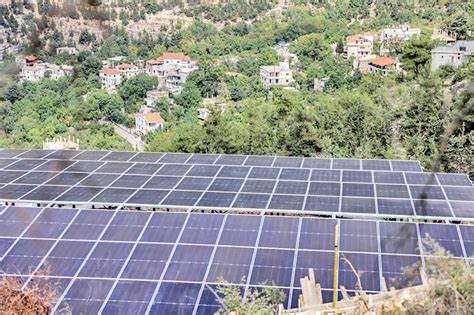Electricity Outages Intensify. Lebanon’s national electricity company (Electricte du Liban or EDL) sells electricity at a loss, for a price below 0.5 cents per kilowatt hour (kWh). The actual overall cost, after taking into consideration technical losses and electricity theft, exceeds 50 cents per kWh. The price was adjusted late 2022 but remains below cost. Those losses have been traditionally covered by the treasury and compounded 45 billion USD in public debt. With the current crisis, the treasury became unable to finance losses, making EDL unable to purchase fuel. EDL’s power outages increased to 22 hours per day. Private Generators (PG) curb the outages problem for a price of 43 cents per kilowatt hour (kWh). They currently supply 16 hours of electricity daily, compared to 2 hours by EDL, reducing outages to 6 hours per day.
Toula’s Solar Farm. Toula is a small town in the north of Lebanon that has been able to bypass the electricity troubles plaguing the country. This town has successfully implemented a solar energy project fully funded by expats. The solar farm costed about $120,000, broken down as follow: $70,000 for the solar equipment and around $50,000 to rehabilitate the selected land offered by a church. The farm produces electricity at a daily average of 10 hours (400 kWh), with a peak of 14 hours (560 kWh) in June and a dip of 4 hours (170 kWh) in December. However, Toula’s 200 households get 24/7 electricity thanks to the solar farm, coupled with a private generator owned by the municipality.
Municipalities. Toula’s pilot project highlights the ability of municipalities to immediately provide 24/7 electricity to their households through partnering with private sector investors (PSIs) and private generators (PGs) as follow: (1) The PSIs provide the initial investment in solar—the $120,000 for 200 households in the case of Toula—and could also rent the land if needed. (2) The PSIs supply electricity to the PGs. (3) The PGs complement the purchased solar energy with their generator and then sell the bundle to households through their already established microgrid and distribution system.
Profitability. Toula’s solar farm produces electricity at 7 cents per kWh over the lifetime of the system, which makes it cheaper for PGs to buy solar rather than to produce electricity using fossil fuel. In reality, PGs already have their generators and the microgrid in place, which will save a hefty amount in initial investment. Under the assumption that the suitable land/roofs[1] are available, the additional investment for the entire Lebanon to produce 24/7 electricity through PSIs (40%) and PGs (60%) would be around $0.7 billion, way below the cost of the government’s plan.
Government Plan. The Ministry of Energy and Water developed a $4.9 billion investment plan in 2010 promising to secure 24/7 electricity by 2014. In 2019, the ministry updated the plan and asked for $5.6 billion in investment. The plan will not be executed in the foreseeable horizon for several reasons: (1) the exorbitant cost in fresh dollars, (2) the ministry’s record in avoiding the scrutiny of the tender board, (3) the desire to build new power plants despite the inability to provide fuel for existing ones, and (4) the absence of credible measures to reduce uncollected bills.
Impact. EDL’s supply could focus on crowded cities that do not have the geographical space to set up solar farms, which improves supply in all Lebanon. The Lebanese parliament is also currently studying a bill to open the door for PSIs to use EDL’s grid. This law can eventually help municipalities hosting renewable energy producers to sell their excessive electricity in peak time to EDL. Shifting renewable energy licensing to the municipal level would allow most of Lebanon to leapfrog to a cleaner, more reliable, more affordable, and more sustainable electricity. This green shift would in turn improve the comfort of everyday life, allow several economic sectors to grow and help people live healthier lives.
[1] In general, villages have enough land space for solar farms. Crowded cities may lack the space, but they can, theoretically, install a solar farm on a distributed set of rooftops. We estimated the need for 25 rooftops to power 100 households.


